Nội dung bài viết
Sometimes a massage that focuses on a specific part of your body just won’t cut it. Maybe you’re in the mood for total relaxation, or you’re after an all-over sense of wellness from a treatment that reaches every nook.
“Full body” can refer to a number of different massage styles across widely-practised set of treatments. With the term covering so many different techniques, newcomers to the world of massage can find it difficult to know what to expect from a full body session. There are also some key differences between individual treatments that are worth noting – here’s a quick rundown.
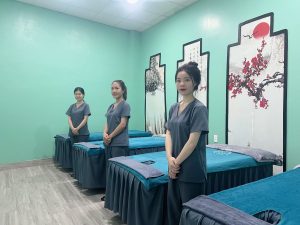
The benefits of full body massage
On top of leaving you generally feeling lighter and more relaxed, studies have shown full-body massage can benefit the body and mind, in particular by:
- Helping with pain management for chronic pain
- Speeding up the recovery process
- Improving sleep quality
- Helping with digestion
- Reducing anxiety
- Easing headaches (although it’s worth contacting your doctor first if you suffer from migraines)

What to expect from a full body massage
You’ll start by lying face down on the massage table
Once you’re comfortable on the table your massage therapist will apply some oil (or they might use wax or balm for a sports massage).
Your therapist will focus on areas of your choosing
Typically this involves your back, legs, arms and hands, and sometimes also your chest and head. Bear in mind there’s no set routine for a full body massage – where a practitioner starts working on your body will change depending on your needs, the amount of time available the practitioner’s approach.
You’ll be covered by a towel throughout the treatment, with the practitioner moving the towel over as they work on different areas of your body. Your therapist should communicate with you throughout to check you’re happy with the pressure.
Following the appointment, you’ll be given some time alone to get dressed. If you can, use the rest of the day to relax and rewind, and drink plenty of water. If you feel any soreness the next day, try taking a warm bath.
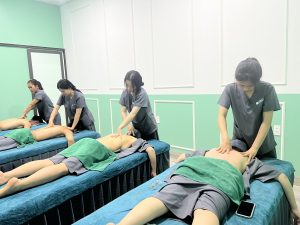
What areas are massaged in a full body massage?
A full body massage typically covers your back, shoulders, neck, legs, arms, hands and head/scalp, in that order. Some therapists will include chest massage if it’s indicated as part of a sports or deep tissue massage (for example to help with restricted breathing).
Your back, shoulders and legs
To begin, your therapist will ask you to lie face-down on the massage table and take a few deep breaths. They’ll prepare you for the massage by adjusting the towel or blanket to cover your legs and feet.
Starting with your back, they’ll warm up your muscles with long, flowing strokes, before moving on to treatment-specific techniques such as deep tissue, Thai or sports therapy. They’ll move onto the backs of your legs up to near your underwear (but no further).
Your arms, hands, face and head
Half-way through the massage your therapist will ask you to turn onto your back and cover your chest, legs and feet with the towel or blanket. They might also place a small towel over your eyes to help you relax further. They’ll massage your shoulders and neck, your arms and hands, and the front of your legs.
They may end with a face and scalp massage, or even an Indian head massage depending on the full body massage you have booked.
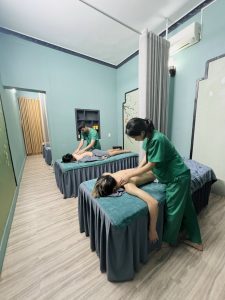
In certain treatments: your chest or stomach
Chest massage is sometimes included as part of a deep tissue or a sports massage to help with neck pain and restricted movement.
It’s performed with you lying on your back with a towel tucked under your armpits, covering your nipples (which should never be exposed). Your therapist will ask you to hold the towel in place while they work on your pectoralis muscles.
Massage therapists are also trained to work on the stomach area, please ask for this if you are comfortable receiving it.
Different types of full body massage
Swedish massage
If it’s your first time delving into the world of full body massage, a Swedish massage might be a safe bet. Therapists use a well-balanced mixture of light and firm pressure, and the process is intended to relax and reinvigorate. It’s rarely uncomfortable, and therapists will work through all of your muscle groups methodically unless you tell them otherwise.
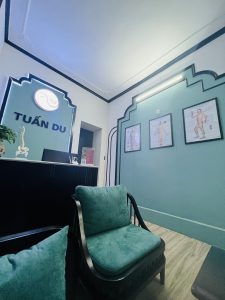
Sports massage
If you’re looking to limber up, sports massage is an altogether more scientific approach which uses a wide range of techniques, including active and passive stretching to release muscle tension and improve your range of motion. However, practitioners are trained to zero in on problem areas, and treatment of a single area can take up most, if not all, of your session.
Deep tissue massages are a little more intense, and focus on reducing tension and stiffness by encouraging blood flow to muscles to speed up their recovery. Pressure is typically firm, and although the treatment is never supposed to cause any pain, it may feel slightly uncomfortable as the strength of the massage ramps up. You’re likely to feel a little sore after the treatment, although this should ease off over the next 72 hours.
Hot stone massage therapy

A hot stone massage combines Swedish massage techniques with the warmth of smooth heated basalt stones. In this ancient practice, stones are used both as an acupressure tool (where they’re placed on precise points in the body), as well as a massage tool, their warmth aiding gliding strokes across the body with massage oil.
The weight and heat of the stones help the massage go deeper by relaxing the muscles. The massage typically covers your arms, legs, back, shoulders and neck, with you holding stones in your hands at some points.
Shiatsu
Shiatsu is a type of full body massage therapy originating in Japan. Shiatsu – which means fingers (“Shi”) and pressure (“Atsu”) – restores the energy balance of your whole body.
It combines stretching and compression techniques along ‘energy pathways’ that run throughout the body, known as meridians, to promote the circulation of Qi (vital energy, pronounced ‘chee’). Its holistic approach means it’s beneficial for mind-body health, calming anxiety and helping to improve insomnia, stress or even migraines.
What should I wear during a full body massage?
Your underwear or loose clothing depending on the treatment
In certain circumstances, it’s possible for you to wear loose clothes or sportswear while you’re massaged (e.g. for treatments like sports and Thai massage). Usually though, you’ll undress to your underwear – keeping briefs or boxers on at all times – which will also be covered by a towel.
It’s up to you if you keep your bra on
If you normally wear a bra, it’s up to you if you keep it on or not; your massage therapist can work around the straps if you’d find this more comfortable.
How is a Swedish-style massage performed?
Typically Swedish massage begins with effleurage strokes, which are smooth, gliding motions towards the heart, used to warm up the muscles and get blood flowing.
Petrissage (from French pétrir ‘to knead’) strokes are then applied; variously squeezing, rolling and rubbing the muscles and skin with the thumbs, fingers and palms to work on tight muscles and knots. It’s much more relaxing than that may sound!
Three other techniques are characteristic of Swedish massage: tapotement, friction and vibration.
Tapotement is a more stimulating technique involving the rhythmic tapping, drumming or cupping of muscle tissue. Used in short bursts it has an energising effect, which is why therapists will often finish a daytime massage with it to wake you up.
Friction in Swedish massage refers to pressing with the ball of the thumb in small circular motions deep into the muscle. This can be especially good for releasing muscle tension and breaking down adhesions (scar tissue).
Finally, vibration in Swedish massage is quite self-explanatory. Your massage therapist will use their fingertips, palm of the hand or fist to create a fine trembling movement to stimulate deeper muscles.

How long do full body massages last?
Full body massages last a minimum of an hour but can be as long as 120 minutes.We recommend at least 90 minutes to get the most out of your full body massage, as therapists can spend longer on each area. Practitioners will usually start with a quick conversation about problem areas to get a feel for what you want out of the treatment.
_____________________________________________________________________________________

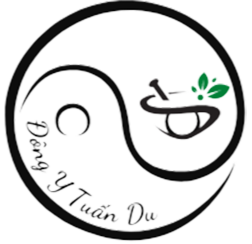
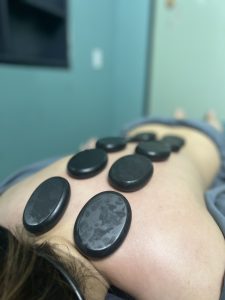





HOT NEWS
Căng thẳng ảnh hưởng như thế nào đến bệnh viêm khớp?
Căng thẳng ảnh hưởng như thế nào đến bệnh viêm khớp? [...]
Tê bì chân tay khi ngủ, vì sao?
Tê bì chân tay khi ngủ, vì sao? Nhiều người bị [...]
Uống trà tâm sen mỗi ngày có tốt không?
Uống trà tâm sen mỗi ngày có tốt không? Trà tâm [...]
Khám liệt nửa người gồm những gì?
Khám liệt nửa người gồm những gì? Liệt nửa người là [...]
Lễ hội Khèn mông huyện Đồng Văn lần thứ X năm 2025 – gìn giữ thanh âm nguồn cội
Lễ hội Khèn mông huyện Đồng Văn lần thứ X năm [...]
Tham quan Làng HMông Pả Vi bình yên của mảnh đất Hà Giang
Tham quan Làng HMông Pả Vi bình yên của mảnh đất [...]